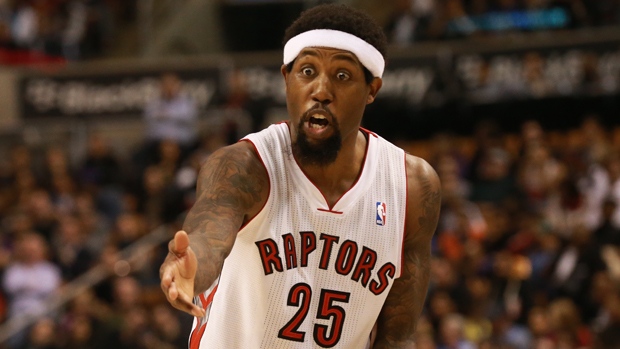Ahead of last Wednesday’s game against the Cleveland Cavaliers, head coach Dwane Casey was asked if he’s ever had an option quite like DeMarre Carroll to throw at LeBron James. Casey thought about it for a moment before offering a tepid endorsement of John Salmons being the closest thing.
With those two words – “John. Salmons.” – I was attacked with flashbacks of the 2013-14 season, when the veteran played an obscene 1,281 minutes over 60 games with the team.
Salmons was acquired from the Sacramento Kings alongside Patrick Patterson, Greivis Vasquez, and Chuck Hayes for Rudy Gay, Quincy Acy, and Aaron Gray on Dec. 9, 2013. In retrospect, it’s one of the most important deals in Raptors history, as it appeared to mark the beginning of a tear-down on the part of general manager Masai Ujiri. Instead, the Knicks balked at surrendering more draft capital for Kyle Lowry, and the new core was accidentally given time to mesh. They found an instant chemistry, unexpectedly vaulting the team to the playoffs, their second Atlantic Division title, and on to an entirely new development path.
The trade’s been covered ad nauseam, but it’s largely been looked at as Patterson, Vasquez (hilariously flipped for Norman Powell and a first-round pick this summer), and Hayes’ Veteran Leadership for Gay and a flier on Acy. It’s been an unmitigated slam dunk for the Raptors, but Salmons’ inclusion in the deal meant a lot more in the months that followed than it seems now, looking back.
Salmons turned 34 days after the trade and, despite years of getting 30-plus minutes, he was hardly the type worthy of 25-a-night on a would-be rebuilding club (or a competitive one, really). As the Raptors found success, Salmons found a role, functioning as Casey’s preferred first wing off the bench for all the reasons a lot of coaches like veterans, the least of which seems to be actual on-court utility.
He would average 21.4 minutes for Toronto that season, scoring five points with two rebounds and 1.7 assists while shooting 36.8 percent from the floor. His 38.8-percent mark from long-range kept him from being a complete zero, but offensive efficiency metrics grade him as far below average. That he was taking minutes from a developing Terrence Ross made things worse, even if Ross’ own minutes were at an acceptable level (26.7).
Casey’s comments made me wonder if I had been unfairly harsh on Salmons at the time. After all, before #FreeJamesJohnson, there was a pretty strong #ImprisonJohnSalmons movement within the fan base. As it turns out, Casey probably overrated the contributions of a savvy, well-traveled veteran. I am Bruno’s complete lack of surprise.
The Raptors were 2.2 points per-100 possessions worse with Salmons on the floor, with his defensive contribution outweighed significantly by the tax he levied on the offense. Even the starting lineup with Salmons in place of Ross was outscored by 7.5 points per-100 possessions, 10.7 points per-100 possessions worse than they were with Ross and 8.8 points per-100 possessions worse than they were in all situations. ESPN’s Real Plus-Minus graded Salmons with a -1.99 RPM, 270th of 437 players and a woeful rank for someone with his playing time.
Here’s what I wrote about Salmons ahead of the 2014-15 season:
There are also differences. John Salmons played 1,281 minutes for the Raptors last season. 1,281. That’s over 21 hours. I googled “what could you do in 21 hours” and here was the fourth link returned:
I don’t know if this is the internet’s way of trying to remind me that I’m projecting the Raptors for one fewer win this year and John Salmons played 1,281 minutes last season, shake it off Blake, shake it off, shake shake shake shake shake shake okay it’s 3 a.m. sorry.
It can’t be overstated how big an upgrade a literal salmon would have been over John Salmons last season. Replacing his minutes with additional run for Ross and the addition of James Johnson is huge. As much as I don’t like adding a combustible element to a team so reliant on an indefinable chemistry, Johnson is a strong defender and fills a major need with his ability to guard larger forwards. He can also guard one through four, which allows him to be deployed with nearly any lineup iteration. You know, assuming they don’t give him the ball, because he sometimes think he’s a Kobe-Nash hybrid.
Let’s ignore the Johnson part of that because…yeah. Sadly, T-Swift no longer returns as a result for that search query. Instead, here’s something from Swift’s contemporary, one who’s had a terrific 2015:
Anyway, back to Salmons: Casey grew to value him less and less. Come playoff time, the 6-foot-7, 210-pound Salmons was deemed unworthy of playing time despite his reputation as a strong wing defender. With Joe Johnson wreaking havoc in three-wing lineups, Salmons played 77 minutes in the series while we all grasped at straws for solutions. The man Casey now identifies as the closest thing he’s had to a Carroll couldn’t get much run in a crucial playoff series where defense was desperately needed.
This isn’t an indictment on Casey, who’s been given a paucity of quality perimeter defenders in five seasons. Nor is it really a criticism of Salmons, who had a productive 13-year career where he was a below-average offensive contributor but a capable outside threat and a decent defender. But he wasn’t very good for the Raptors, despite his heavy run.
And hey, the Raptors flipped his partially-guaranteed salary to the Atlanta Hawks for a year of Lou Williams and the Lucas Nogueira lottery ticket. Salmons is still helping, kind of!



